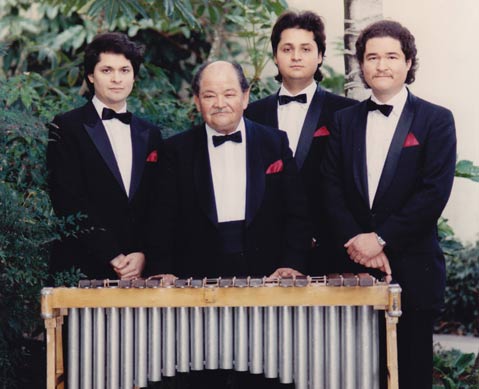Lorenzo ‘Lencho’ Martinez
1923-2009

No one typified the sound of Santa Barbara more-or played it longer-than Lorenzo “Lencho” Martinez. Playing marimba and vibraphone, Lencho brought the snap, sway, and syncopation of Latin rhythms to Fiesta and other parties and community events for 63 years. His fusion of dance tunes and ballads made him a popular figure at the Biltmore Resort for more than 30 years, and his greatest thrill was to perform with his talented sons whom he personally trained-Lorenzo Jr., Ruben, and Rene.
Lencho was born in Veracruz, the third of six children, and the family later moved to Mexico City, where his stepfather often performed on the marimbas. As a young lad, Lencho helped his stepfather haul and set up his equipment for parties and clubs, watching him perform, listening and learning. Then, one day, with no training and no lessons, Lencho just picked up the mallets and started playing. (“He has a gift from God,” explained his son Ruben.) By the age of 13, Lencho was performing professionally at clubs, cantinas, and street parties. He loved playing regional songs, such as “Cielito Lindo,” but also the other Latin rhythms just gaining popularity in Mexico-sambas, mambos, rhumbas.
Within five years, Lencho graduated to specialty orchestras and was playing for Mexican stars such as Pedro Infante. He was featured regularly on XEB, Mexico City’s first radio station. After a gig playing for a wealthy American rancher, Lencho and his group had an opportunity to move to California. In 1943, at age 19, Lencho came to Santa Barbara and was hired to play at El Paseo Restaurant with bandleader Manuel Contreras and his wife, singer Leonora Palacio. The following year, Lencho married Leonora’s sister Jennie, who was a singer and marimba player as well.
Contreras played for Xavier Cugat’s world-renowned orchestra, which at some point during the 1950s needed a marimba player. Contreras encouraged Lencho to audition. Lencho demurred, saying he lacked the skill to play for the classically trained master musician, but Contreras persisted, packing up Lencho and his gear and driving him down to the Statler Hotel in Los Angeles.
In the hotel lobby, a myriad of marimba players hung around, waiting to be called. As the musicians began to talk shop, they asked Lencho what music he had brought, and whether he had looked over Cugat’s scores. No, Lencho stated, he had not. In fact, he confessed, he did not even know how to read a single note of music. The musicians laughed openly. Who could believe anyone would be so naive as to audition for Xavier Cugat’s Orchestra, unable to read music?
However, Lencho innately understood what was required by the repertoire. He got the job, and was often referenced as Cugat’s best marimba player. He toured the world with Cugat-marimba-ing his way through Japan, Hong Kong, and the Philippines, and even performing for the King of Siam. He spent six months at the Waldorf Astoria in New York. He was featured in the soundtrack of the film L’Americano with Glenn Ford and Abbe Lane singing.
After four years on tour, Lencho abandoned life on the road to remain with his family in Santa Barbara full-time. He returned to El Paseo, performing with his wife and guitarist Tony Sunseri, or with I. Newton Perry on piano. A regular fixture of Fiesta starting in the 1940s, Lencho provided music for Jose Manero’s dancers during the 1950s and 1960s, played for the Mercado de la Guerra street dances during the 1970s, and radiated good vibes at Noches de Ronda and Tardes de Ronda, and literally hundreds of parties, for more than half a century. He played traditional folk dances such as chiapanecas as well as rhumbas and waltzes.
In the decades before 1990, when flamenco became dominant, the very sound of his marimbas was a harbinger of Fiesta. Ellen Harte, 1995 Fiesta La Presidente, recalled, “His music is what I hold in my memory of Fiestas as a child. My family lived near Lencho, and in July, when he would start practicing on his marimba, the entire neighborhood knew Fiesta was almost here.” In 1998, Old Spanish Days Fiesta honored Lencho for his contribution to the unique culture and history of Santa Barbara with its first History and Traditions Award.
Lencho lived and breathed music and everything he played had a certain graciousness: formal yet friendly, sophisticated yet inclusive. He could play anything in any key once he heard the melody. Susan Parent remembers going to the Biltmore after performing in the El Paseo dance shows. “Lencho would see me and smile and immediately switch out to play some of my dance music. He would do this without missing a beat or taking a break. There was no musical segue, he would simply and automatically cut in the music and back to the original song, as though it was all part of the same melody.” It was Lencho’s characteristic musical wink.
Perhaps we mourn Lencho’s departure not only for his musical genius, but also the passing of an era-his sound was evocative of a time when gentlemen still wore jackets in the evening, bougainvillea draped the outdoor patio under an August moon, and people didn’t want to leave town during Fiesta, because a neighborhood party was beckoning from just around the corner.



